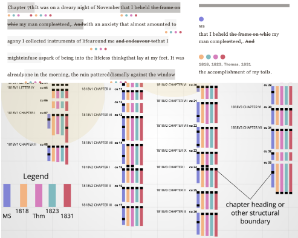News
ATNU Virtual Speaker Series - Elisa Beshero-Bondar - 2022-06-14

Our next speaker in the ATNU Virtual Speaker Series is Elisa Beshero-Bondar who will talk to us about the delights and provocations of an experiment in collating five versions of Mary Shelley’s Frankenstein to prepare a digital variorum edition. She is Professor of Digital Humanities and Program Chair of Digital Media, Arts, and Technology at Penn State Erie, The Behrend College.
Join us on Tuesday 14 June 2022 via Zoom at 4pm UK time (BST). (We will send the zoom link to all registered attendees shortly before the event.)
Missed the Event? Click here for a recording of it!
"It's alive! The Frankenstein Variorum and adventures in machine-assisted collation"
Dr Elisa Beshero-Bondar
Tuesday 14 June 2022
4pm (BST)
Abstract: We have been working on a challenging experiment with automated text-collation to compare and visualize five distinctly different versions of the novel Frankenstein, by Mary Wollstonecraft Godwin Shelley. Working with computer-aided collation involves much testing and refining as the process inevitably does not run smoothly. In our case, the collation process is complicated by our comparison of very differently-encoded digital editions: the Shelley-Godwin Archive's diplomatic TEI edition (encoding page-by-page surfaces and zones as well as marginal insertions and deletions), together with simpler encodings of four other editions mainly representing print publications and their semantic structures (encoded in chapters and letters). I will discuss how we organized the collation process by “chunking” the documents along parallel structures marked in each text, and also how we involve the TEI markup of paragraph and chapter boundaries as well as deletions and insertions in the process to make the markup part of the collated edition.
Most importantly, I want to discuss the necessity of good, clear documentation to guide our testing of collation methods and analysis of what can go wrong and how to resolve it. We are now working to determine the viability of Python-assisted delivery of "flattened" markup to collation software as a stream of text, since we have been struggling to contend with spacing errors in the output collation. My students and I have been testing whether this process is correctable (or worth correcting) and alternatively whether XSLT is the better choice for handling the collation process within our edition production pipeline. In the process of this testing, we are working hard to improve our documentation so that our production methods are fully legible by our peers and future scholars working on related projects.
Bio: Elisa Beshero-Bondar explores and teaches document data modeling with the XML family of languages at Penn State Erie, The Behrend College, where she is a Professor of Digital Humanities and Program Chair of Digital Media, Arts, and Technology. She serves on the TEI Technical Council and is the founder and organizer of the Digital Mitford project and its usually annual coding school. She experiments with visualizing data from complex document structures like epic poems and with computer-assisted collation of differently encoded editions of Frankenstein. Her ongoing adventures with markup technologies are documented on her development site at newtfire.org.
Last modified: Wed, 22 Jun 2022 15:24:38 BST
